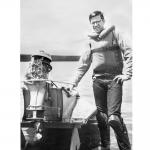I have recently finished a complete mechanical restoration on a nice complete PO-15 (22 HP) Johnson....the big iron twin beast! I acquired it and a little 1956 Johnson 7.5 for later restoration from a good friend of mine. The old PO-15 is a fishing model, but somebody long ago got the bright idea of putting on a racing carb (Vacturi-500). This carb is a monster. It has about a 2" throat and about a 1-3/4" venturi from the looks of it. I did the grease to hypoid oil conversion on the lower unit with all new sectional gaskets (basically, move the end prop shaft bushing just under 1/4" inward and press in a 1-1/8"OD-7/8" ID seal). These engines never had seals of any kind. The heavy waterproof grease acted as such (lousy idea, but pretty much worked). The drive shaft had no worries as it is completely encased within the shaft mid/tube where nothing could get in from outside. I took her all apart and checked it all out. I cleaned out the two separate cooling systems (prop thrust feed type) in both the powerhead and exhaust. They feed from a vent behind the prop and are totally separate with separate outlets (good design! Better cooling). I made all new gaskets including head gaskets.......
Making head gaskets from reinforced material (metal embedded), outside can be cut with heavy shears, holes cut with ground old sharpened sockets of size with hammer, and cylinder hole is carefully cut with a hammer and narrow sharp flat shaped chisel along the mark...works nicely upon a flat anvil/vise. Smooth cut!!
I soldered some nice Belden plug wires on the coil as well. I put on fresh Blue Crown cool range spark plugs I got with the motor (cant get those anymore!). I gapped the point to .020 and put on a dab of lithium to keep it lubed.
The pistons, rings and cylinders are perfecto!!! Very nice internals. I oiled it all up inside upon reassembly and "good gosh" the compression is high!!!
Buddy, you'd better eat them Wheaties to crank this old Gas-Punk beast! And that's with one cylinder working. The other has a relief valve, and yeah, you would need it. It would take a truck to pull it over with both cylinders pressing....I was told it has high compression "soup up" heads. Oh well!
Another neat thing is the automated idle relief valve (great idea!). The way it works is that the piston valve drops the let off back pressure from exhaust. When the engine starts up, the water cooling pressure pushes the valve piston up to close the exhaust relief.
Well amidst all this jabber, I am ready to take it fishing all day! What I would like to know is what the idle and high-speed settings were initially for the Vac-500 carburetor. They were used on Hubbel and Johnson PR racers I think? Thanks!!


 Thanks:
Thanks:  Likes:
Likes: 


 Reply With Quote
Reply With Quote

Bookmarks